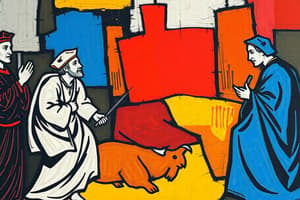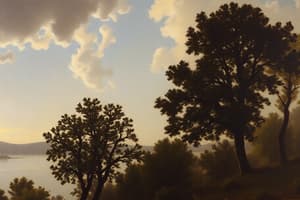Podcast
Questions and Answers
Which of the following is an accurate description of the Renaissance?
Which of the following is an accurate description of the Renaissance?
- A period marked by a decline in trade and a focus on insular, local development.
- A period of artistic, scientific, and intellectual flourishing that followed the medieval period. (correct)
- A period focused solely on religious art and architecture, rejecting classical influences.
- A brief period primarily affecting only Italy, with minimal impact on the rest of Europe.
How did the commercial revolution influence the Renaissance?
How did the commercial revolution influence the Renaissance?
- By shifting the focus of artistic expression towards more mercantile themes.
- By providing the financial resources necessary for artistic and exploratory endeavors. (correct)
- By fostering intellectual pursuits through the establishment of universities.
- By causing a decline in artistic patronage due to economic instability.
What role did patrons play during the Renaissance?
What role did patrons play during the Renaissance?
- They offered financial and material support, enabling artists to focus on their craft. (correct)
- They were primarily responsible for distributing artworks to the general population.
- They primarily dictated the subject matter and style of artworks.
- They served mainly as art critics, guiding public opinion on artistic merit.
How did Renaissance artists incorporate humanist ideals into their work?
How did Renaissance artists incorporate humanist ideals into their work?
What was the significance of chiaroscuro in Renaissance art?
What was the significance of chiaroscuro in Renaissance art?
How did Renaissance artists approach perspective in their drawings and paintings?
How did Renaissance artists approach perspective in their drawings and paintings?
What distinguished Donatello's sculpture from those of the classical era?
What distinguished Donatello's sculpture from those of the classical era?
Which of the following is true of Leonardo da Vinci's artistic practice?
Which of the following is true of Leonardo da Vinci's artistic practice?
Michelangelo is best known for which of the following?
Michelangelo is best known for which of the following?
What was a key characteristic of Raphael's artistic style?
What was a key characteristic of Raphael's artistic style?
Flashcards
The Renaissance
The Renaissance
A period from the mid-1400s to late-1600s marked by a flowering of art and sciences, following the medieval period.
Chiaroscuro
Chiaroscuro
The practice of shading to make objects appear round and real.
Renaissance Patrons
Renaissance Patrons
Wealthy individuals or groups, like the Medici family or popes, who supported artists during the Renaissance by providing them with time, money and resources.
Leonardo da Vinci
Leonardo da Vinci
Signup and view all the flashcards
Michelangelo
Michelangelo
Signup and view all the flashcards
Raphael
Raphael
Signup and view all the flashcards
Donatello
Donatello
Signup and view all the flashcards
Study Notes
- The Renaissance was a flourishing of art and sciences following the medieval period.
- It spanned from the mid-1400s to the late 1600s, occurring at different times in different places.
- The Renaissance influenced art, religion, philosophy, literature, and all other intellectual inquiry.
- It emerged from Italy due to its responsive government.
- A commercial revolution financed the Renaissance and voyages of discovery.
- European trade spread globally to China and India, with the Portuguese first, followed by the Dutch, French, and British establishing trading footholds in the 1500s and 1600s.
- Europe began to play a prominent global role.
- The Renaissance was a period of significant development in art, sculpture, and architecture.
- Patrons, including popes of the RCC, wealthy businessmen, and Italian princes, played a major role in enabling this development.
- Wealthy princes like the Medici of Florence and Sforza of Milan supported hundreds of artists.
- Patrons provided artists with time, money, and space for experimentation, research, and practice, accommodating them with housing and servants.
- Renaissance art was heavily concerned with religious themes but not exclusively.
- Portraits of well-known figures reflected the humanist interest in individual achievement, often set against classical Greek and Roman backgrounds.
- Donatello produced the first Greek classical sculpture of a man on horseback since classical times.
- Renaissance artists returned to the Roman practice of realism and developed new techniques.
- Artists created a sense of perspective by drawing distant objects smaller.
- Chiaroscuro was a shading method used to make objects appear round and real.
- Leonardo Di Vinci, Michelangelo, and Raphael were the three most celebrated Florentine masters.
- Leonardo made thousands of meticulous sketches from nature.
- He secretly studied human anatomy through corpse dissection and intricate drawings.
- Leonardo's paintings, such as the Mona Lisa, are admired for their realism.
- His patrons included Medici, Sforza, and the King of France.
- Michelangelo was a sculptor, architect, and painter.
- Michelangelo's sculpture, David, produced for Florence, is considered one of the greatest works of the Renaissance, and he also worked for Medici and popes in Rome.
- Raphael studied the works of former Renaissance masters and his works, such as the Sistine Madonna, blend Christian and classical styles.
- Raphael ran a successful workshop, combining his artistic gift with business acumen, with patrons including the popes in Rome, Medici Pope, and Pope Leo X.
- In Northern Europe, Albrecht Durer produced very realistic works.
Studying That Suits You
Use AI to generate personalized quizzes and flashcards to suit your learning preferences.




